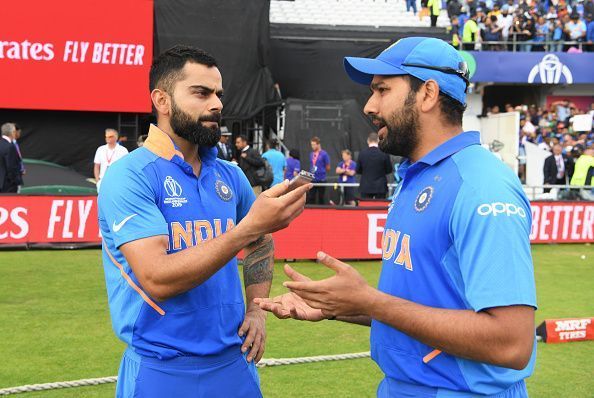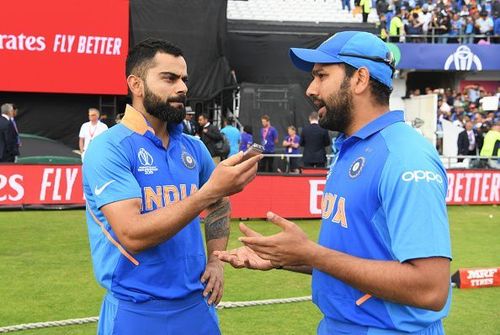
Virat Kohli, Rohit Sharma placed above Hardik Pandya in ICC's flawed T20I all-rounders' rankings

What if I told you that Virat Kohli was the best all-round option India has in T20Is currently? What would happen if Rohit Sharma came in as the first-change bowler, replacing Jasprit Bumrah in a crunch game? I’d probably be taken as a mad-man babbling incomprehensible in this cricketing frenzy country.
Well, in my defence I certainly have cricket’s highest authority, the International Cricket Council (ICC), supporting me with numbers that not many can even comprehend.
Current all-rounder rankings
According to the ICC T20I all-rounder rankings, regular Indian captain Virat Kohli is the top-ranked Indian player, sitting pretty at the 19th position with 130 rating points. What’s bizarre is the fact that the next best Indian player in the same list is batsman (now all-rounder) Rohit Sharma at the 39th place with 73 points. Indian players with all-round skills in T20Is like Hardik Pandya is ranked as low as 40th in comparison to Virat Kohli. A total of five Indian players feature in the top 100 with Krunal Pandya (ranked 50th) and Vijay Shankar (ranked 86th) being the other two.
Breakdown of rankings' algorithm
The official website of ICC states that rankings in all three formats are a way of recognizing players who could fill in the spots of the World XI if it were to be picked today. Not only does the rankings give an account of an entire player’s career but it also takes into account that player’s recent form. The average of a player doesn’t reflect what form he or she is experiencing, the circumstances in which the runs were scored or wickets taken, the opposition or even the nature of the pitch. Hence, the rankings were introduced by the ICC.
After every match, the performance of a player is assessed. All international players are rated between 0 to 1000 points for both batting and bowling. In the case of T20Is, a bowler giving away 10 runs, for example, will earn more rating points than another bowler taking two wickets and giving away 40 runs. Similarly, a half-century scored in 20 balls would be rated higher than a similar score in 50 balls. Economy and strike-rates play a decisive role in deciding the rankings. A batter or bowler, having ratings of over 900 is considered legendary.
However, in the case of all-rounders, an overall rating of 300 is deemed to be world-class. To decide this index, a player’s bowling and batting ratings are multiplied and then divided by 1000. For example, a player having 500 batting and 200 bowling ratings will get an index 100. Similarly, any player having 500 batting but zero bowling ratings will get a resultant index of zero, and won’t be considered an all-rounder.
Why are Virat Kohli and Rohit Sharma above the Pandya brothers?
In 72 T20Is, apart from his expected abundance of runs, 2450 to be exact, Virat Kohli has been able to take only four wickets at a not so proud average of 49.50. His first wicket was the prized scalp of Kevin Pietersen in the only T20I played at Manchester on India’s tour of England in 2011. On the return tour, Kohli took Samit Patel’s wicket in the only T20I played in Kolkata in 2011. The other two wickets were claimed by Kolhi in the World T20s in 2012 and 2016, taking the wickets of openers Mohammad Hafeez and Johnson Charles respectively. Interestingly, all wickets were taken under MS Dhoni’s leadership.
Moving on to the bowling record of swashbuckling opener Rohit Sharma, the Mumbai batsman took his only wicket almost a decade back against Sri Lanka when he bowled Tillakaratne Dilshan in the first T20I in Nagpur.
So going in accordance with the ICC formula of deciding the all-rounder's rankings, Kohli and Sharma's colossal batting rating all these years have helped them maintain a respectable all-rounding standard by overshadowing their low bowling performances (if at all).
The question arises, won’t their rating drop accordingly in all these years of a no-show in the bowling department? This is what ICC has to say:
What happens to a player's rating if he plays but does not bat/bowl ?
If a batsman does not bat, his rating is unchanged. We don't want the ratings to punish a player when he hasn't done anything wrong (and it would be tough if, for example, rain wiped out an innings causing all the team to lose points). The situation with bowlers is slightly different. If the opposition are bowled out for less than 150, then a bowler who has not bowled, is not penalised (conditions obviously suited the other bowlers, and his services weren't needed).
So, following the above rule, it won’t come as a surprise that Virat Kohli and Rohit Sharma are placed where they are in the current T20I all-rounder rankings considering India’s stupendous performance in T20Is over these years.
Conclusion
The permutations and combinations that have led them to their current rankings are remarkably confusing. The rating system should be a true reflection of a player’s capability and in this case, the ICC has faulted leaps and bounds. The system deciding the index should be more transparent, something that can be easily deciphered by the layman. But till the time the ICC understands this, let’s enjoy the best Indian T20I all-rounders in action and hope to not see them shouldering the bowling department as well in the T20 World Cup in Australia next year.
Follow Sportskeeda for all the updates on England vs New Zealand head to head, England vs New Zealand schedule 2019, news, results, points table, most runs, most wickets and fantasy tips.